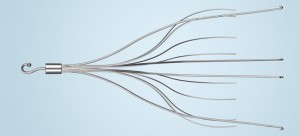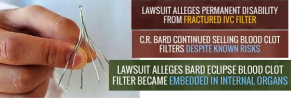
Plaintiffs have been asserting claims as a result of a surgically implanted medical device, known as a G2 Filter System (hereafter G2, G2 Filter, or G2 Filter System), causing serious and ongoing physical, emotional, and economic damages.
The G2 Filter was designed, manufactured, prepared, compounded, assembled, processed, labeled, marketed, distributed, and sold by C.R. Bard from approximately September 2005 to the present for prevention of blood clots (thrombi) from traveling from the lower portions of the body to the heart and lungs.
The lawsuits allege that C.R. Bard knew and should have known that the device was defective and unreasonably dangerous for, inter alia, the following reasons:
- Bard failed to conduct any clinical testing, such as animal studies, to determine how the device would function once permanently implanted in the human body.
- Bard knew and/or should have known that the Recovery Filter and G2 filter system had a high rate of fracture, migration, and excessive tilting and perforation of the vena cava wall once implanted in the human body. Bard know and/or should have known that such failures exposed patients to serious injuries, including: death; hemorrhage, cardiac/pericardial tamponade; cardiac arrhythmia and other symptoms similar to myocardial infarction; severe and persistent pain; perforations of tissue, vessels, and organs; and inability to remove the device. Upon information and belief, Bard also knew or should have known that certain conditions or post-implant procedures, such as morbid obesity or open abdominal procedures, could affect the safety and integrity of the device. Further, Bard knew and should have known that these risks for the Recovery device and the G2 filter were and are substantially higher than other similar devices.
- Bard knew and/or should have known that the Recovery Device and G2 filter contained conditions, which Bard did not intend, which resulted in the device not performing as safely as the ordinary customer would expect.
- Despite being aware of these risks, Bard misrepresented, omitted, and/or failed to provide adequate warnings of these risks or instructions for safe use.
- Even when Bard designed and began marketing what they alleged to be a device that specifically reduced these risks, they still failed to issue a recall or notify consumers that a safer device was available.
The IVC filter at issue in this case bears the trademark name “G2” filter or “G2 Filter System”. The G2 Filter System (hereafter “G2” or “G2 Filter”) was manufactured, marketed, and sold by C.R. Bard, Inc. and/or Bard Peripheral Vascular, Inc., from September 2005 until approximately 2015. Bard has now stopped manufacturing and selling the product.
An IVC filter is a device that is designed to filter or “catch” blood clots (called “thrombi”) that travel from the lower portions of the body to the heart and lungs. IVC filters may be designed to be implanted, either permanently or temporarily, in the human body, more specifically, within the inferior vena cava. The inferior vena cava is a vein that returns blood to the heart from the lower portions of the body. In certain people, for various reasons, thrombi travel from the vessels in the legs and pelvis, through the vena cava and into the lungs. Oftentimes, these thrombi develop in the deep leg veins. These thrombi are called “deep vein thrombosis” or “DVT”. Once thrombi reach the lungs, they are considered “pulmonary emboli” or “PE”. Pulmonary emboli present grave risks to human health. They can, and often do, result in death.
Certain people are at increased risk for the development of DVT or PE. For instance someone who undergoes knee or hip joint replacement is at risk for developing DVT/PE. Obese patients are also at increased risk for DVT/PE. So too are people who have vascular diseases or whom have experienced previous strokes. A number of other conditions predispose people to develop DVT/PE.
Those people at risk for DVT/PE can undergo medical treatment to manage the risk. For example, a doctor may prescribe medications like Heparin, Warfarin, or Lovenox to regulate the clotting factor of the blood. In some people who are at high risk for DVT/PE, or who cannot manage their conditions with medications, physicians may recommend surgically implanting an IVC filter to prevent thromboembolic events.
Over the years, a concern developed within the medical community, which was shared with IVC filter manufacturers, that an IVC filter should be designed and manufactured so that it is able to be retrieved from the human body. Ultimately, retrievable IVC filter designs were offered in the market. However, these IVC filter designs were not intended to remain within the human body for indeterminate periods of time. In other words, the initial designs of retrievable IVC filters were intended to remain implanted for a finite period of time. The Recovery Filter System2 (discussed in more detail infra) was introduced to the market in late 2002 or 2003 (and subsequently removed from the market in late 2005) as an IVC filter that was able to be retrieved after an indeterminate time of placement within the human body.
The G2 Filter System is a medical device constructed of a nickeltitanium alloy (also called “Nitinol”) designed to filter blood clots (thrombi) from the human circulatory system. Nitinol material is unique. Nitinol is actually an acronym that stands for Nickel Titanium Naval Ordnance Laboratory. Nitinol is also unique as it possesses “shape memory.” That is, Nitinol will change shape according to change in temperature, and then, retake its prior shape after returning to its initial temperature. This quality makes Nitinol appealing for use in certain medical devices, including IVC filters.
The Recovery Filter System was plagued with manufacturing and design defects which caused the Recovery Filter System to experience a significant rate of fracture and migration of the device. Studies performed in the medical and scientific communities established that the Recovery Filter had a 21% to 31.7% rate of fracture. The failure of the Recovery Filter System, as aforesaid, was attributable, in part, to the fact that the Recovery Filter System was designed so as to be unable to withstand the normal anatomical and physiological loading cycles exerted in vivo.
Sometime after 2003, the Defendants made a decision to introduce a substitute vena cava filter for Bard Peripheral Vascular’s vena cava filter product line. This substitute vena cava filter was meant to replace the Recovery Filter System. It was to be called the “G2 Filter”. G2 stands for “second generation”. In 2005, Bard submitted an application to the F.D.A for introduction of the G2 Filter to the global market. The application was submitted under Section 510(k) of the United States Food, Drug and Cosmetic Act (“Act”) of 1976 (21 U.S.C. 321 et seq). Under Section 510(k), a medical device manufacturer may represent that the device which is offered for approval is “substantially similar” to a “predicate device”. With regard to the G2 Filter, Bard represented to the F.D.A that it was substantially similar to the Recovery Filter System (the predicate device).
The Recovery Filter System and the G2 Filter System bear a strong resemblance in a number of respects. First, they look strikingly similar in appearance and have the same design for filtration. That is, the G2 Filter System has six upper struts used for device positioning and filtering, and, six lower struts used for anchoring and filtering-just like the Recovery Filter. In addition, the G2 Filter System is made of the same alloy material as the Recovery Filter System. They both were manufactured of Nitinol. Like the Recovery Filter, the G2 Filter System is inserted via catheter
that is guided by a physician (typically an interventional radiologist) through a blood vessel into the inferior vena cava. Both filters are designed to be retrieved in a somewhat similar fashion. Following endovascular placement of the G2 Filter System, a physician typically uses imaging studies (such as x-rays, “vena cava grams” or CT scans) to confirm successful placement and positioning of the device within the vena cava.
Unfortunately, the G2 Filter System also shares some of the defects of its ancestor. The G2 Filter System design causes it to be of insufficient integrity and strength to withstand normal placement within the human body. The global stressors of the respiratory and cardiac cycles of the human body cause the G2 Filter System to develop stress or “fatigue” fractures of the Nitinol surface of the device. Also, like its predecessor, in addition to design defects, the G2 Filter System suffers from manufacturing defects. These manufacturing defects primarily include the existence of “draw marking” and circumferential grinding markings on the exterior of the surface of the device. The presence of these draw markings and/or circumferential grinding markings further compromises the structural integrity of the G2 Filter System while in vivo. In particular, the G2 Filter System is prone to fail at or near the location of draw markings/circumferential grinding markings on the struts of the device. Put simply, the G2 Filter System is not of sufficient strength to withstand normal placement within the human body. The presence of the aforementioned exterior manufacturing defects makes the device more susceptible to fatigue failure.
The G2 Filter System is advertised by Defendants, C.R. Bard, Inc. and/or Bard Peripheral Vascular, Inc., to have “enhanced fracture resistance,” “improved centering,” and “increased migration resistance.”
A review of the MAUDE database from the years 2004 – 2008 reveals data to establish that the Defendants’ vena cava filters (including the G2 Filter System) are responsible for a significant percentage of the reported adverse patient events involving vena cava filters. Specifically, the G2 Filter System and the Recovery Filter account for and are responsible for the following event percentages: a. 50% of all “adverse events”; b. 64% of all occurrences of migration of the device; c. 69% of all occurrences of vena cava wall perforation; and, d. 70% of all occurrences of filter fracture.
The failure (fracture and/or migration) of the G2 Filter System leads to a number of different, and potentially fatal, complications. These complications include, but are not limited to: a. Death; b. Hemorrhage; c. Cardiac/pericardial tamponade (pressure caused by a collection of blood in the area around the heart); d. Severe and persistent pain; and, e. Perforation of tissue, vessels and organs.


